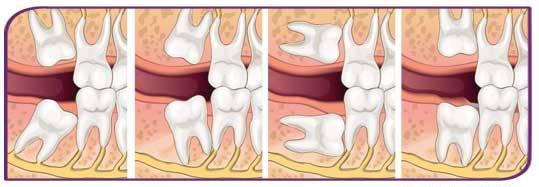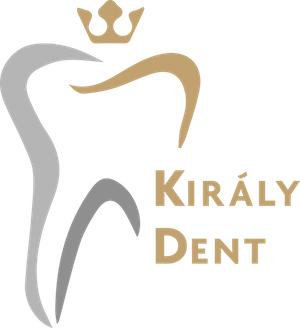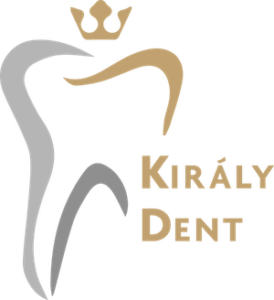Wisdom Teeth Surgery
 Wisdom teeth are the third and final set of molars that most people get in their late teens or early twenties. Sometimes these teeth can be a valuable asset to the mouth when healthy and properly aligned, but more often, they are misaligned and require removal. When wisdom teeth are misaligned, they may position themselves horizontally, be angled toward or away from the second molars, or be angled inward or outward. Poor alignment of wisdom teeth can crowd or damage adjacent teeth, the jawbone, or nerves. Wisdom teeth also can be impacted — they are enclosed within the soft tissue and/or the jawbone or only partially break through or erupt through the gum. Partial eruption of the wisdom teeth allows an opening for bacteria to enter around the tooth and cause an infection, which results in pain, swelling, jaw stiffness, and general illness. Partially erupted teeth are also more prone to tooth decay and gum disease because their hard-to-reach location and awkward positioning makes brushing and flossing difficult.
Wisdom teeth are the third and final set of molars that most people get in their late teens or early twenties. Sometimes these teeth can be a valuable asset to the mouth when healthy and properly aligned, but more often, they are misaligned and require removal. When wisdom teeth are misaligned, they may position themselves horizontally, be angled toward or away from the second molars, or be angled inward or outward. Poor alignment of wisdom teeth can crowd or damage adjacent teeth, the jawbone, or nerves. Wisdom teeth also can be impacted — they are enclosed within the soft tissue and/or the jawbone or only partially break through or erupt through the gum. Partial eruption of the wisdom teeth allows an opening for bacteria to enter around the tooth and cause an infection, which results in pain, swelling, jaw stiffness, and general illness. Partially erupted teeth are also more prone to tooth decay and gum disease because their hard-to-reach location and awkward positioning makes brushing and flossing difficult.
Removal of wisdom teeth is recommended in the following cases:
- if persistent inflammation and pain develops around the tooth
- if there is no room for the wisdom tooth
- if there is a constant pain and inflammation around the tooth
- if the wisdom teeth pushing all the teeth causing congestion
- if the adjacent tooth root absorbed caused by the pressure
- if they don’t emerge in the right direction, they may irritate the mucous membranes of the face
- if you have any facial pain of unknown origin
- if pocket forms around it, which can not be healed
Wisdom tooth removal procedure
During the removal of wisdom teeth under local anesthesia, the tooth is liberated from the gum ensuring the integrity of the neighboring teeth. To do this, in some cases it may be necessary to remove bone as well, so that we can reach the tooth.
Finally, the wound is closed with sutures that are removed after 7 days.
Healing after the wisdom tooth extraction
The first 24 hour
Bleeding – Bleeding may occur for several hours after tooth extraction. To control it, position a piece of clean moist gauze over the empty tooth socket and bite down firmly. Apply constant pressure for about 45 minutes. A moistened tea bag is an effective alternative. The tannic acid in tea helps healing blood clots to form (blood clots function similarly to scab over an open wound). Repeat this process if a small degree of bleeding continues; if heavy bleeding continues to occur, contact your dentist or oral surgeon. Avoid rinsing or spitting for 24 hours after tooth extraction, avoid “sucking” actions (for example, don’t drink beverages through straws or smoke) and avoid hot liquids.
Facial swelling – To minimize swelling, place a piece of ice, wrapped in a cloth, on that area of your face on a schedule of 10 minutes on, followed by 20 minutes off. Repeat as necessary during this first 24-hour period.
Pain relief – Use a pain killer if needed!
Meals – Foods should be restricted to a liquid diet until all the numbness from anesthesia has worn off. Eat soft foods for a few days. Also avoid alcohol and narcotic pain medication.
Brushing – Brushing is still important, but avoid the teeth directly neighboring the extracted tooth during the first 24 hours. On day two, resume the gentle brushing of those teeth as well.
After 24 hours:
Facial swelling – Facial swelling in the area of the tooth extraction should be treated with heat after the first 24 hours of ice. Apply a moist warm towel to the area on a 20-minute on, 20-minute off schedule. Repeat as necessary.
Salt water – Rinse your mouth with warm salt water (1/2 teaspoon of salt in a cup of warm water) after meals and before bed. Do not use commercial mouth rinses, these can cause irritation
Stitches – Stitches, if they did not used a self-dissolving type, need to be removed in about 1 week.
Complete healing – Complete healing may take a few weeks to a few months following the extraction. However, usually within the first week or two, enough healing has taken place for use of your mouth to be reasonably comfortable in the area of the extraction.

